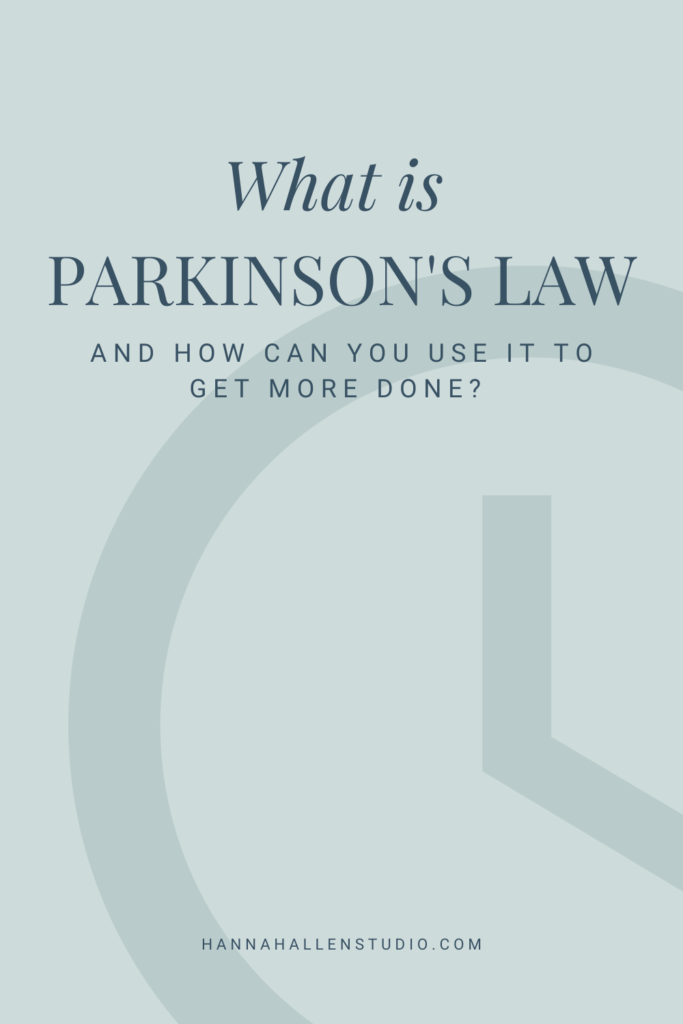Were you one of those kids who always turned assignments in on time…but waited until the last minute to finish them? (Guilty over here!) Maybe you’ve outgrown that habit (good for you!), but chances are, you haven’t. And, even if you weren’t that kid, chances are that you’re spending too much time on certain tasks and you don’t even realize it.

Parkinson’s Law states that work expands to fill the time allotted for its completion (source). In other words, if you allow an hour for a task, you’ll get it done in an hour. But if you have 5 hours? It’ll take you 5 hours to complete that same task.
So, how do we use Parkinson’s Law to our advantage?
It’s no secret that I’m a big proponent of timers. (You can blame my mom—she always set timers for us to complete tasks growing up.) Part of the reason I love them so much is because of Parkinson’s Law—with timers, I have a hard-and-fast stopping point. The timer goes off and I should be done with the task.
Sometimes it doesn’t work perfectly, but if we know exactly how long we have to complete the task at hand, we’re much more likely to finish it in that amount of time. And, if the task or project isn’t completely finished, we can strategically make two choices:
- We can set the timer again and finish the task
- We can set the task aside and move on to something else, allotting time later to finish it
If it’s urgent, or urgent and important, choose option 1. If it’s important but not urgent, choose option 2. And if it’s neither important or urgent…well, you probably should either delegate, automate, or eliminate it. 🙂 (Think you’re ready for a Virtual Assistant? Here’s how to know!)
By allocating specific time restraints to our tasks, we can make sure we aren’t dragging out projects and tasks. We can easily move on to the next thing and get more accomplished in our days and weeks.
Tips for setting time boundaries
I’ll be the first to admit that I often underestimate how long it will take me to do something. I’ve learned that I need to add extra time on to my gut estimates, and that usually gives me a more realistic time estimate. Here are a few tips to setting time boundaries, so you can be successful in putting Parkinson’s Law to use!
1. Don’t go with what you wish to be true.
Yeah, you might want your yearly taxes to take 15 minutes, but the reality is that they’ll probably take longer than that. Be realistic, and if you’re like me, pad your estimates with extra time so that you won’t be stressed.
2. Track your time!
If you actually don’t know how long something takes, track your time! (This is a helpful habit to build anyway!) I use Toggl—it makes it quick and easy. It might take a few times to get an average, but in the long run, if you’re allocating time for a recurring task, it’ll be worth it to track on the front end! (Read more about how I use Toggl to track my time here!)
3. Move your phone.
We all do it—we’re doing a task where we really should be focusing, and then all the sudden, we’re scrolling through Instagram. Move your phone out of reach so you can stay focused and won’t grab it out of habit!
4. Keep a notepad nearby.
When you’re doing focused work, sometimes your brain is running a-mile-a-minute and #allthethings come to mind. Keep a notepad nearby so you can jot those thoughts down without getting distracted!
Ok—now, go set that timer, move your phone, and knock out that task you’ve been putting off!
Pin this to read later!


comments
0
leave a comment
share this post on: